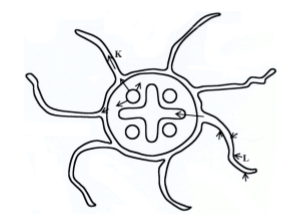KNEC KCSE Biology Paper 1 Question Paper / KCSE 2014
KCSE 2014
Biology Paper 1
State the importance of each of the following in living organisms: (a) nutrition (b) excretion. (1 mark)
1 marks
(a) What is meant by the term seed dormancy? (1 mark)
(b) State three causes of seed dormancy. (3 marks)
4 marks
State two functions of the placenta in mammals. 4 The diagram below illustrates a growing pollen tube.
2 marks
The diagram below illustrates a growing pollen tube.
(a) Name the part labelled B. (1 mark)
(b) Explain the role of the parts labelled A .(2 marks)
3 marks
The diagram below shows a set up for an experiment to demonstrate a certain physiological process.
(a) What nature of solution is represented by 20% sugar solution? (1 mark)
(b) Explain the observation made on the set up after one hour. (2 marks)
3 marks
State three roles of auxins in a plant stem.
3 marks
A student drew a 6cm long diagram of a plant flower. If the actual length of the flower was 12cm, calculate the magnification of the drawing made by the student. Show your working. (2 marks)
2 marks
Differentiate between phenotype and genotype as used in genetics.
1 marks
State two functions of intervertebral discs in the mammalian skeleton.
2 marks
10 (a) Explain two roles of diffusion in human beings. (4 marks)
(b) What is meant by each of the following terms?
(i) Crenated cell. (1 mark)
(ii) Flaccid cell. (1 mark)
6 marks
State three differences between tactic and tropic responses.
| Tactic responses. | Tropic responses. |
| . | . |
| . | . |
| . | . |
3 marks
The diagram below represents a model used to demonstrate breathing in mammal.
(a) Name the mammalian structure represented by the parts labelled D and E. (2 mark)
(b) State the observation made when the string is pulled downwards. (1 mark)
(c) Explain the observation in (b) above. (3 mark)
6 marks
State one function of each of the following parts of a mammalian eye:
(a) eye lashes (I mark)
(b) lachrymal glands. (I mark)
2 marks
State three structural differences between DNA and RNA.
| DNA | RNA |
| . | . |
| . | . |
| . | . |
3 marks
(a) Which type of mammalian muscles is voluntary? (I mark)
(b) Distinguish between a tendon and a ligament. (I mark)
2 marks
The diagram below illustrates a nerve cell.
(a) Name the type of nerve cell illustrated. (1 mark)
(b) Give a reason for your answer in (a) above. (1 mark)
(c) Identify the part labelled J. (1 mark)
(d) State one function of each of the parts labelled G and H.
(i) G. (1 mark)
(ii) H. (1 mark)
5 marks
Give a reason why the image is not formed when light is focused on the blind spot.
1 marks
Explain why
(a) mammalian testes are located to hang outside the body (2 marks)
(b) four months after fertilisation, ovaries can be removed from a human female, without terminating pregnancy. (2 marks)
4 marks
Why is a burning charcoal stove in a poorly ventilated room likely to cause death of the inhabitants?
3 marks
State one function of each of the following cell organelles:
(a) golgi bodies (1 mark)
(b) lysosomes. (1 mark)
2 marks
Name the type of skeleton that makes up each of the following animals:
(a) locust. (I mark)
(b) bird. (I mark)
2 marks
(a) Name two vestigial structures in human beings. (2 marks)
(b) Why are some bacteria able to resist the effect of antibiotics? (2 marks)
4 marks
Below is an illustration of a cross section of a plant root showing the transportation of substances in the plant.
(a) Name the substances transported along the paths labelled K and L. (2 marks)
(b) Give a reason for your answer in L above. (1 mark)
3 marks
The table provided shows the transportation of substances in the human body.
| Substance | Transported by blood From | Transported by blood To |
| Oxygen | M | Whole body |
| N | Liver | Kidneys |
| P | Intestine | Whole body |
Name the substances represented by
M( I mark)
N( I mark)
P (I mark)
3 marks
State two roles of luteinising hormone in human reproduction.
2 marks
The table provided shows the concentration of sodium and iodine in sea water and cell sap of a plant.
| Substance | Sodium ion concentration | Iodide ion concentration |
| Sea water | 250 | 35 |
| Cell sap | 100 | 550 |
(a) (i) Name the process through which the plant cells take up sodium ions. ( I mark)
(ii) Give a reason for your answer in (a) (i) above. ( I mark)
(b) If the plant was sprayed with a chemical that inhibits respiration:
(i) which of the two ions uptake will be affected? ( I mark)
(ii) give a reason for your answer in (b) (i) above. ( I mark)
4 marks
The diagram below shows the gaseous exchange system of a locust.
Muscle tissue
(a) Name the structure labelled Q. (I mark)
(b) State the function of the part labelled R. ( I mark)
(c) How is the part labelled S structurally adapted to its function? (2 marks)
4 marks













how can I download?